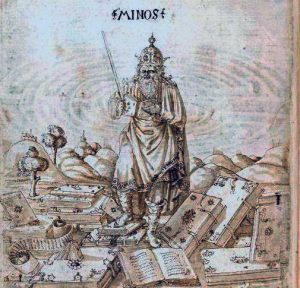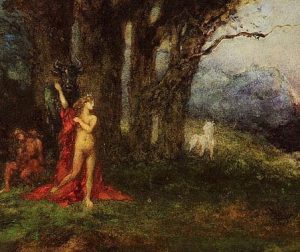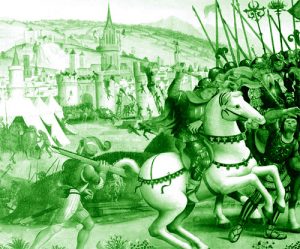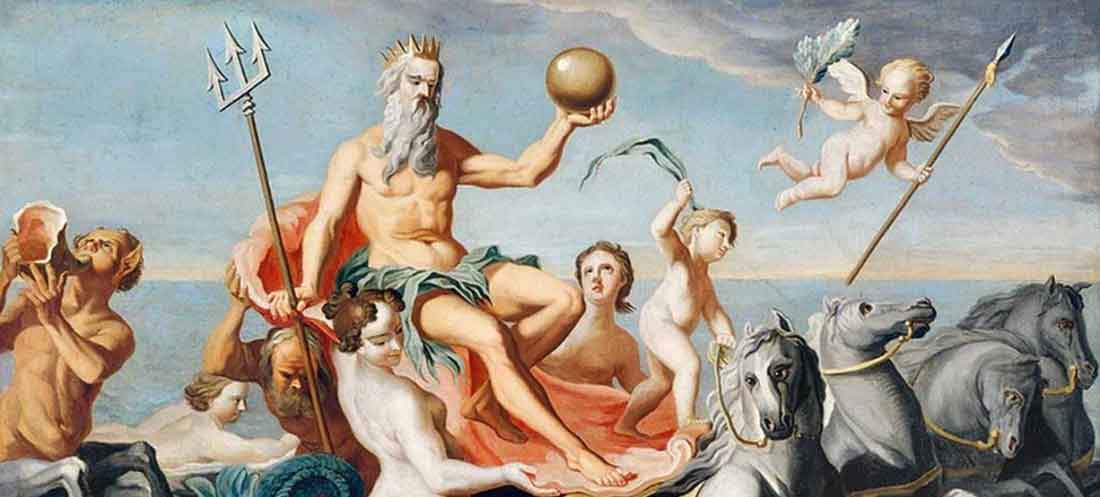Who was king Minos of Crete
King Minos is considered to be the son of Zeus and Europa, with a mortal father Asterios or Asterion, king of Crete, or the son of Europa and Asterion himself. His brothers were Sarpedon and Rhadamanthys. Later mythographers attributed his father to the prince of Knossos Tauros, who, after a campaign in Tyre, brought the king’s daughter, Europa, captive to Crete. This Taurus also founded Gortyna.
 According to a rather later version of the myth, the succession of power to the three brothers took place peacefully with a distribution pre-determined by Asterios. Still others say the succession has been tumultuous. Minos believed and maintained that the gods destined him to be king of Crete. He proved his superiority and the preference that the gods had for him, when they actually sent him everything he asked for, as Minos had predicted to his brothers.
According to a rather later version of the myth, the succession of power to the three brothers took place peacefully with a distribution pre-determined by Asterios. Still others say the succession has been tumultuous. Minos believed and maintained that the gods destined him to be king of Crete. He proved his superiority and the preference that the gods had for him, when they actually sent him everything he asked for, as Minos had predicted to his brothers.
When he was bound and sacrificed to Poseidon, he asked him to send a bull from the sea, which would be sacrificed in his honor. (Fig. 71) And while this act of Poseidon secured his power bloodlessly and unchallenged, Minos did not sacrifice the animal; on the contrary, he sent it to his herds both because of its beauty and to preserve its breed.
For this act of transgressing the divine command, Minos and Crete were punished, as Poseidon unleashed fury on the bull. Pasiphae must have fallen in love with this bull later and this bull was killed by Heracles at the behest of Minos or as one of the labors imposed on him by Eurystheus.
According to another version of the myth by later mythographers, Minos received an oracle to wait for a sign from the sea. With ships and an army came from the Cretan sea a general, Taurus, who united his forces with that of Minos, who in this way found himself in greater power and assumed power.
The Love affairs of Minos
From the union of Minos with Pasiphae (daughter of the Sun and Perseid or Crete) or Crete (daughter of Asterius), the following children arose: Deucalion, Glaucus, Androgeus (or Eurygyis), Catreas, Ariadne, Phaedra, Acallis ( or Akakallida), Xenodiki. But he also fathered many illegitimate children with various women. From the Nymph Paria (or a girl from Paros) he had Eurymedon, Chrysis, Nephalion, Philolaus.
From the Nymph or queen of Kea Dexithea he had Euxanthios.
From other women he had other children who became founders of cities outside Crete or occupied various regions. (The eugenics of Minos was the mythical explanation of the spread of the empire).
Minos’s love for Vritomartis, Demeter’s granddaughter, is also witnessed. (Figs. 72, 73) She loved hunting and forest walks and had invented the hunting net. Minos fell in love with her and chased her for nine months. He brought her to a cape, where her clothes got tangled in a myrtle.
To avoid Minos, he fell into the sea but was saved by fishermen’s nets. (Fig. 74, 75, 76) Then the Cydones, the oldest inhabitants of Crete, named her Diktynna, dedicated to her the Mount Dikteo and worshiped her as a goddess. According to another version, the girl was the daughter of Zeus.
From Phoenice it reached Argos and then Kefallinia, where the locals named it Lafria. From there he went to Crete. To save himself from Minos he hid in fishermen’s nets. One of the fishermen, Andromeda, took her to Aegina. When he wanted to join her, she ran into the forest and got lost.
Instead of her they found a statue of her. They declared the place holy, called it Afaia = invisible and worshiped it as a goddess. In essence, we have two deities with common characteristics and a common model, Astarte of Gaza.
Vritomartis and Diktynna in eastern and western Crete respectively were identified as a single Minoan deity. Life in the forest, running and hunting, jumping and bathing in the sea suit Artemis, the Moon and her phases at night. Minos also fell in love with Perivoia, one of the first Athenian potential victims of the Minotaur.
The Cretan origin of the myth is testified among others by Plato and Athenaeus (Deipn. 13.77.7), while the story of Ganymede’s abduction by Minosin Troy and the suicide of the young man in Crete out of nostalgia for his family and his place is preserved in the Souda dictionary. According to Plato, the myth is a justification for the enjoyment of pleasures by the Cretans. In addition, in historical years, the initiation of homosexuality, with an educational content and the ultimate goal of the social inclusion of the young in the institutions, political, military, religious, was considered a Cretan invention of Minos
Minos was also called the lover of Theseus. She reconciled with him after Ariadne’s abduction, and as a sign of sincere reconciliation gave him his second daughter, Phaedra, as his wife.
At the beginning of his reign, Minos did not have children, because he suffered from a venereal disease: they came out of the body of the reptile that ate the entrails of every woman who lay with him (a memorialized horror from the transmission of a skin disease that in ancient times exterminated tribes).
 Only Pasiphae was not harmed, because she was the daughter of Helios. According to another version of the myth, Pasiphae cast a spell on him, because Minos had many mistresses. So the women who went with him were devoured by scorpions and snakes that came out of his body. He was healed by Procris, daughter of the king of Athens Erechthea, who had fled to Crete to escape her husband’s revenge.
Only Pasiphae was not harmed, because she was the daughter of Helios. According to another version of the myth, Pasiphae cast a spell on him, because Minos had many mistresses. So the women who went with him were devoured by scorpions and snakes that came out of his body. He was healed by Procris, daughter of the king of Athens Erechthea, who had fled to Crete to escape her husband’s revenge.
Minos fell in love with her and Procris agreed to go with him in exchange for a pole that never missed its mark and a dog that never ran away from him. Then he cured him with an herb, the so-called “root of Circe”. Other accounts have Procrida using the skin or bladder of a goat, with which she made a bladder which she placed in the vagina of a woman and protected her, as snakes and other reptiles were kept there and did not spread into her body. After that he joined Pasiphae and they had children.
Exercise of power
Minos received from Zeus the golden scepter and the laws by which he ruled, entrusting their implementation to Rhadamanthys in the capital of the state and Talos in the villages. Every nine years Minos retired alone to Ida, the cave where Zeus was born and rescued in Psiloritis, in the very center of Crete at an altitude of 1500m. There he consulted the god or heard the laws from him and wrote them down.
The epithet nine-hour attributed to Minos is explained by the renewal of the law every nine years or because Zeus was his teacher since Minos was nine years old and for nine years he taught him the art of kyberan. His justice in life placed him above the other two judges of the underworld, Rhadamanthys and Aiacus, for the dead of Asia and Europe respectively.
The sea rule of Crete in the Aegean since the second millennium is all centered around Minos and is attributed to him. He was considered the inventor of the epacteris, a small and nimble ship, with which he rid the Aegean of pirates, made travel and trade easier, established Cretan sovereignty over the seas and enforced peace. At the same time, internal reforms made it possible to expand as far as Caria in Asia.
So it was considered that he united the Cretans and the 90 or 100 states of Crete under his scepter, built new ones, made Knossos the center, civilized the Cretans. With a fleet, very swift for his time, he expanded to the islands of the Aegean and the coasts of Asia Minor, freed the seas from pirates and drove the wild tribes into the interior of Asia; the rest accepted to be ruled by Minos.
He colonized deserted islands, built cities in the Cyclades, appointed his children as rulers, founded colonies and trading posts, the Minoans or Minoides. Minos, lawgiver, ruler, sea ruler, conqueror, was ultimately the founder of a historical formation.
The decentralized system of administering justice and maintaining order, as described in the Minos dialogue, with Rhadamanthys overseeing the administration of justice in the cities, Talos in the countryside, and Minos the general overseer, a two-headed king, is a creation of the classical era. After all, laws and customs that went back to an honored past gained prestige.
Thus, the Commentator On Plato’s Gorgian (189, 28) notes: “They worshiped the gods, not only the dog and other animals, but also plants, ὢmnion, ὢmnion, rhadamanthyus of this taught, like the fissi of Suidas; the one according to a goose or a dog or a plane tree or a ram or some other such thing… Such are also the Socratic oaths.
Minos in Athens
 When Aegeus was king of Athens, Minos reached the Saronic region and besieged Megara and Athens to avenge the murder of Androgeus’ son.
When Aegeus was king of Athens, Minos reached the Saronic region and besieged Megara and Athens to avenge the murder of Androgeus’ son.
Androgeos presided over great festivals with games organized by Aegeus (Panathenaia). Then the king sent him to kill the wild bull of Marathon, the bull that Poseidon sent to Minos and he did not sacrifice. Heracles brought the bull tied to Eurystheus, and he released it, until it became the fear and terror of the region.
Adrogeos could not face him and lost his life in Attica. Others say that Androgeus was the victim of a conspiracy by Aegeus and his brother Nissus, king of Megara, at Oinoe in Attica, on Androgeus’ road to Thebes. Still others want him to be a victim of the envy of his competitors in the games in memory of Laius. The Athenians put forward this last version of their not guilty of the murder, to show that Minos struck the city without being sure of their guilt.
The news of his son’s death found Minos in Paros, where he was sacrificing to Charites. He concluded the ceremony by throwing away the wreath and calling for the flute to stop (thus justifying the local cult custom of sacrificing to Charites without wreaths on the heads and without flute). From there, Minos set sail for Saronic and managed to conquer Megara only thanks to the love he inspired in his daughter Scylla or because he tempted her with jewels (allusion to the wealth and aesthetics of Crete). And Athens he was able to conquer only after the intervention of Zeus who sent a pestilence to the city.
The oracle they asked said to pay for the murder of Androgeus the penalty that Minos would set. And he appointed every nine years, seven boys and seven girls, food for the Minotaur as long as the monster lived.
The third time the Athenians had to pay the tax, because the Athenians were dissatisfied with their king Aegeus, the son of Theseus asked that he himself be sent to the island, so that he might appease the crowd. But it was said that Minos himself chose the victims and that time he included Theseus. In case they managed to stay safe and be saved from his mixed-race and strange son, being unarmed, he would allow them to return to Athens. However, the inability of Minos to subdue Athens by his own forces alone, as well as the cruelty he displayed as a conqueror in imposing such a severe punishment, underline the greatness of the vanquished and the power of the city even in the most remote times of its existence.
Minos in Kea
Then Minos headed to Kea. Three days earlier Zeus burned the people of the island, and King Damon, except for his daughter Dexithea, because when Zeus once visited the island, only the queen welcomed him willingly. The old inhabitants were the Telchines, wild people who practiced magic and destroyed the spartans with their evil eye (blasphemy as the cause of destruction is an element promoted by some religious center).
Thucydides says that the criminals from the islands were resurrected under him [Minos]. From the union of Minos with Dexithea was born Euxantios or Euxantios, founder of Korisos, the first state on the island, and father of Miletos.
Sophocles, who introduced the cult of Asclepius to Athens, was after his death worshiped as Dexion, because he received or received the god. So Dexithea may be the local queen of the pre-Minoan population who first embraced the Minoan cult.
Minos left half his army and fleet there, which indicates his policy of settlement: he set up outposts at the extreme limits of his territory. Of course, the same tactic may also indicate the beginning of its weakening.
Minos in Sicily
When the craftsman Daedalos was forced to leave his hometown of Athens and take refuge in Crete, with his art he contributed to the technological progress and cultural development that accompanied the political prosperity of the island. He built palaces with luxurious halls, statues, altars, baths, the labyrinth, a marble choir where Ariadne and her friends danced during the great festivals of the year.
When Pasiphae helped Daedalus to escape from Crete, he took refuge in Sicily, then called Sicania, in the city of Kamikos or Inikos, where Akragas was later built, near King Kokalos who hosted and protected him.[12] With fleet and army Minos chased him from place to place showing a snail and a thread and promising gold to the one who would pass the thread through the snail. The king of Sicily Cocalus through Daedalus succeeded, and this revealed the place where the craftsman was hiding. According to another version, Minos’ challenge caused Daedalus’ identity to be revealed, as the craftsman could not resist the temptation and went into the process of solving the riddle. However, Kokalos, at the prompting of Daedalus, agreed to hand him over, after first hosting Minos in his house.
Death of Minos
Inside the bath, Minos fell dead at the hands of the king’s daughters after Daedalus’ prompting or because they decided it themselves. In the first version, Daedalus advised them either to keep Minos longer in the hot water or to bathe him in hot water or scalding tar. Another variation wants Daedalus, in consultation with the daughters, to drill a hole in the ceiling of the bath and from there insert a pipe that came out directly above the bath tub.
He poured hot water on him. This is how Minos died. [13] Kokalos delivered the body to the Cretans, saying that the king had slipped in the bath. They buried him on the spot in a double tomb: in the interior they placed the ashes of Minos, while a second room was a sanctuary of Aphrodite.[14] The locals made offerings at the grave not knowing who was buried there. The bones were uncovered when Akragas was being built and Theron demolished the tomb, identified by an inscription and sent to Crete.
After the death of Minos his lads clashed for power and the natives burned their fleet. Unable to return to Crete, they stayed in Sicily. Some built near Kamikos the city of Herakleia Minoa, some others built Engyio, which developed more when other Cretans arrived there after the Trojan War, led by Mirionis. When the death of Minos in Crete was learned, a large fleet was sent to besiege Kamikos. The siege lasted five years without the city falling. A pestilence also fell and the Cretans fled, scattered here and there by the bad weather. Those who were saved arrived, after a storm, in Iapygia, where they founded Hyria, forgot their homeland and became terrestrial. Internal strife forced some to leave.
They asked for an oracle where to settle and the oracle specified the place where they would be offered to eat soil and water. In Vottia, Macedonia, children who were playing offered them “placenuts” of mud. There they settled after permission they got from the king to allow them to do so without having to clash.
